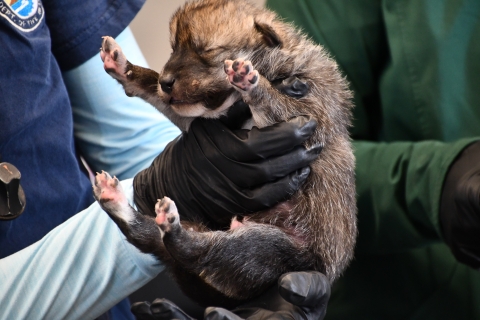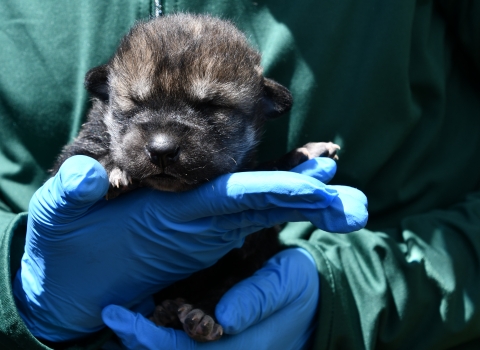A record 27 Mexican wolf pups were fostered into wild dens this spring. Now in its ninth year, fostering is helping to improve the genetic diversity of the wild population of Mexican wolves. The newborn Mexican wolf pups came from six genetically diverse litters held in five AZA Saving Animals From Extinction (SAFE) member institutions across the country, and were placed into eight wild dens in Arizona and New Mexico over a month starting mid-April.
“There are 27 new, more genetically diverse, endangered Mexican wolves on the landscape thanks to the combined efforts of our SAFE partners and our field team,” said Maggie Dwire, Deputy Mexican Wolf Recovery Coordinator for the U.S. Fish and Wildlife Service. “It has taken time, but we are seeing fostering yield results as genetic indicators in the wild stabilize and improve. The hope is this surge of pups will continue to push those trends in the right direction, resulting in a healthier wild population and bringing us closer to recovery.”
Fostering is a method used by the Mexican Wolf Interagency Field Team to increase genetic diversity in the wild Mexican wolf population. It begins with selective breeding by the SAFE program to produce genetically diverse pups for release into the wild. Within 14 days of whelping (being born), the SAFE-born pups are transported and mixed with similarly aged wild pups in the dens of wild Mexican wolf packs. Once all the pups are placed back into the wild den, the breeding female will spend the next several weeks caring for both the wild and SAFE-born pups. With the help of her pack mates, the pups will be raised with the skills and knowledge needed for a life in the wild.
Fostering Mexican wolves has proven successful, with a minimum of 18 pups surviving to two years of age (from 83 fosters released between 2016 and 2022). This minimum number represents fosters that have been captured or documented surviving through DNA analysis. The field team will continue working to document additional foster survival during the 2024 field season and end-of-year count and capture operation. The Mexican Wolf Recovery Plan calls for 22 released wolves to survive to breeding age to achieve recovery.
Additional documented success from the program include:
- The addition of 27 pups this year brings the total number of fosters to date to 126, fostered into 48 wild dens.
- Several packs in the wild have had notable success at raising fosters, including Elk Horn (4 pups), Iron Creek (4 pups), Hoodoo (4 pups), and San Mateo (3 pups).
- At least 10 fostered wolves have successfully bred and produced litters in the wild. Fostered Mexican wolves have produced more than 20 litters and several of those offspring have gone on to produce pups of their own.
- This year, two of the eight dens fostered into had one breeding adult who was itself a foster.
“This has been another banner year for improving genetic diversity in the wild Mexican wolf recovery population,” said Jim deVos Arizona Game and Fish Department Mexican Wolf Coordinator. “The 27 pups fostered this year were placed in eight different dens in the recovery area to bring the total of recipient dens to 48. This points to the ability of spreading the genetic contribution of the fosters into a wide geographic area, amplifying the benefit of the foster program. In addition, these pups will learn how to live successfully in the wild from an experienced female which is yet another benefit of fostering over release of adults that have been maintained in captivity.”
This year’s fosters came from the following SAFE facilities:
- Five pups (including the 100th Mexican wolf foster pup) came from the Living Desert Zoo in Carlsbad, New Mexico.
- Seven pups came from the Brookfield Zoo Chicago in Illinois.
- Six pups came from the Endangered Wolf Center in Eureka, Missouri.
- Five pups came from the Wolf Conservation Center in South Salem, New York.
- Four pups came from two different litters at the Sevilleta Wolf Management Facility in New Mexico.
“The Mexican Wolf SAFE program is honored to be part of such an inspiring and collaborative effort,” said Kim Scott, Mexican Wolf SAFE Coordinator. “The 60 AZA SAFE program facilities are an incredibly dedicated group of zoological and conservation organizations across Mexico and the United States whose primary mission is to support the recovery of the Mexican Wolf. I am so proud of their efforts and commitment to supporting the interagency field team in this incredibly important recovery objective. We also could not have done this without the support of LightHawk an amazing group of volunteer pilots we partner with to get this precious cargo delivered directly to the recovery area and into the hands of the awaiting field team.”
The field team will continue to monitor the wild packs where pups were placed into through GPS and radio telemetry signals from collars on adult and sub-adult wolves within the pack. Supplemental food caches are provided for the first six months for packs with fosters to assist with survival of the litter. Later, through remote camera observations, field observations, DNA analysis of scat samples and efforts to capture the young of the year, the field team will work to document survival of pups fostered this year as well as those fostered in previous years.
Fostering is a coordinated effort of the U.S. Fish and Wildlife Service, Arizona Game and Fish Department, New Mexico Department of Game and Fish, Bureau of Land Management, U.S. Forest Service, and the Saving Animals From Extinction program. Aerial support for this year’s operations was provided by LightHawk Conservation Flying and the Arizona Game and Fish Department’s Aviation Program.
For more information visit www.fws.gov/mexican-wolf.




